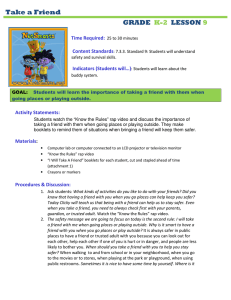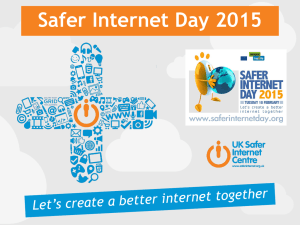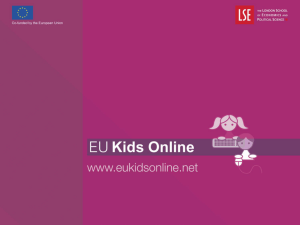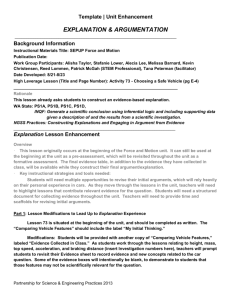Children Online Empowering Protecting Safer Internet Programme
advertisement
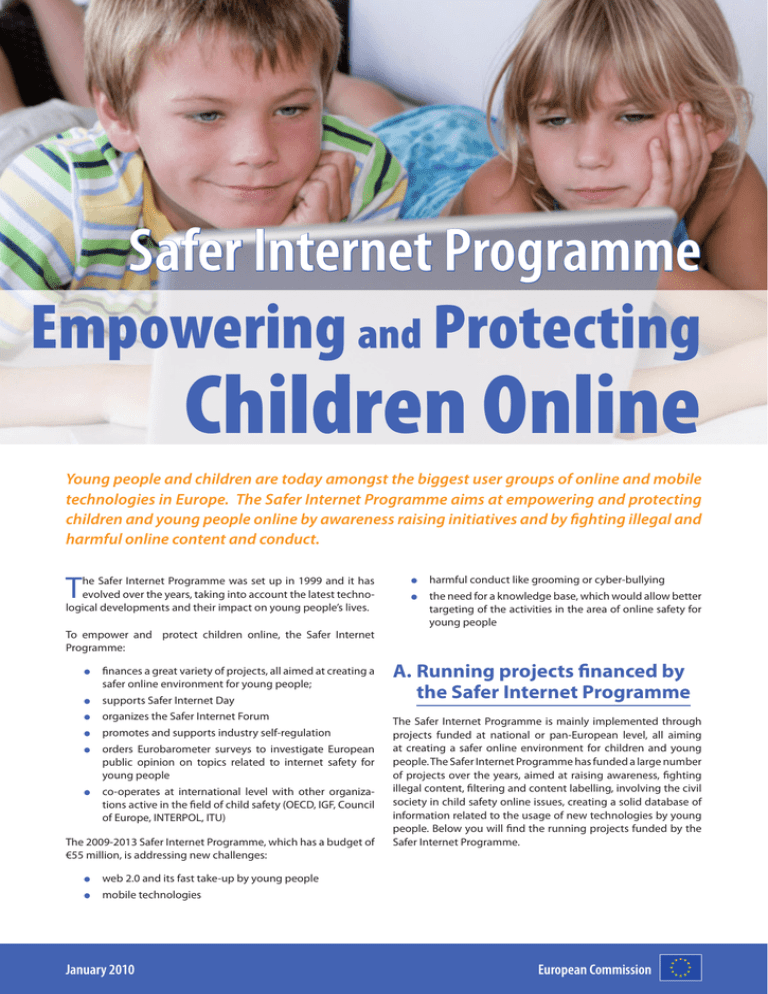
Safer Internet Programme Empowering and Protecting Children Online Young people and children are today amongst the biggest user groups of online and mobile technologies in Europe. The Safer Internet Programme aims at empowering and protecting children and young people online by awareness raising initiatives and by fighting illegal and harmful online content and conduct. T he Safer Internet Programme was set up in 1999 and it has evolved over the years, taking into account the latest technological developments and their impact on young people’s lives. ● harmful conduct like grooming or cyber-bullying ● the need for a knowledge base, which would allow better targeting of the activities in the area of online safety for young people To empower and protect children online, the Safer Internet Programme: ● finances a great variety of projects, all aimed at creating a safer online environment for young people; ● supports Safer Internet Day ● organizes the Safer Internet Forum ● promotes and supports industry self-regulation ● orders Eurobarometer surveys to investigate European public opinion on topics related to internet safety for young people ● co-operates at international level with other organizations active in the field of child safety (OECD, IGF, Council of Europe, INTERPOL, ITU) The 2009-2013 Safer Internet Programme, which has a budget of €55 million, is addressing new challenges: ● web 2.0 and its fast take-up by young people ● mobile technologies January 2010 A. Running projects financed by the Safer Internet Programme The Safer Internet Programme is mainly implemented through projects funded at national or pan-European level, all aiming at creating a safer online environment for children and young people. The Safer Internet Programme has funded a large number of projects over the years, aimed at raising awareness, fighting illegal content, filtering and content labelling, involving the civil society in child safety online issues, creating a solid database of information related to the usage of new technologies by young people. Below you will find the running projects funded by the Safer Internet Programme. European Commission 1. The Safer Internet Centres The Safer Internet Centres are responsible for promoting a safe, responsible use of the Internet and mobile devices to young people. The Safer Internet Centres are now present in 27 European countries all with an awareness centre, and most including a helpline and a hotline. (see map) The awareness centres’ main aim is to develop awareness raising material, organize campaigns and information sessions for young people, parents, carers and teachers in order to make them more aware of the potential risks young people may encounter online and to empower them to stay safe online. The helplines can offer personalized advice to young people, parents and teachers about how to stay safe online. The awareness centres and helplines belong to the INSAFE network http://www.saferinternet.org co-ordinated by European Schoolnet. The objective of the FIVES project is to develop novel investigative tools specifically tailored for investigations involving images and videos of child sexual abuse. 6 partners from 5 different European countries work on this project. 3. Setting up a knowledge base on young people’s use of new technologies a. EU KIDS Online II (Enhancing knowledge regarding European children’s use, risk and safety online) Running 01/07/2009 to 30/06/2011 Safer Internet Project funding: 2.5 million € project, coordinated by a management group from 5 countries. The project builds on the earlier work of EU Kids Online I, which compared available research across 21 countries . b. POG (Understanding the process of online grooming: the behaviors of men who target young people online) Running 01/06/2009 to 30/11/2011 Safer Internet Project funding: 420.000 € POG is the first European research project that will study the characteristics, behaviour and motivations of sexual offenders who have used the internet to groom young people. Researchers a. The European NGO Alliance for Child Safety Online (ENACSO) The European NGO Alliance for Child Safety Online (ENACSO) consists of children’s rights NGOs leading efforts on child internet safety from across the EU. It will forge joint strategies for change, and promote its recommendations to national, European and international decisionmakers and other relevant stakeholders, including in relation to the way the governance of the internet develops into the future. The hotlines are the place where the public can report illegal content they encounter online. They are co-ordinated by INHOPE http://www.inhope.org. ICELAND 5. Filtering and content labeling a. CIRCAMP (COSPOL Internet Related Child Abusive Material Project) Running: 01/11/2008 to 31/10/2010 Safer Internet Programme funding: 540.000 € NORWAY a. SIP-Bench 2: Benchmarking of parental control tools for the online protection of children The goal of this project is to establish a thematic network within the European Law Enforcement community in order to facilitate the exchange of information and best practice between countries in Europe, and thereby increase the effectiveness of international police cooperation in the fight against child sexual abuse. 14 partners from 13 different countries, as well as Interpol and Europol take part in this project. A new benchmarking study of filtering software and services currently available will be running between 2010-2012 with first results available in October 2010. Every 6 months a ranking list will be produced to help European parents to choose the parental control tool that best fits their needs. The study will also aim at increasing users’ confidence in access control systems and the awareness of their filtering potential. b. i-Dash (The Investigator’s Dashboard) The first SIP-Bench study was carried out over the period 20062008 through an annual benchmarking exercise of approximately 30 parental control products or services. Its results show that overall tools have improved over the last three years and have become easier to install. Running: 01/07/2008 to 30/06/2010 Safer Internet Programme funding: 800.000 € This project’s objectives are the development of an operational system capable of handling thousands of hours of videos potentially containing child sexual abuse images to be used for police investigation. Furthermore, it aims to establish a model allowing for multi-nation exchange of information on known child sexual abuse video. 5 partners from 3 different European countries are working on this project. B. International co-operation c. FIVES (Forensic Image and Video Examination Support) In addition to its European members, INHOPE also includes members from Australia, Canada, Taiwan, Japan, Russia, South Africa, South Korea, the US. Running: 01/02/2009 to 31/01/2011 Safer Internet Programme funding: 550.000 € 1 INHOPE’s international membership ■ ■ Police investigations of child sexual abuse cases often face the problem of handling large amounts of seized equipment. ••• 2 4. Involving civil society Running: 01/09/2008 to 31/08/2010 Safer Internet Programme funding: 300.000 € EU KIDS Online II is the first study including most of the Member States, conducted on both parents and children in order find out more about their attitudes and actions towards online risk and safety. This information will allow better targeting of the activities under the Programme and other actions with the same objective. 24 different European countries will work together on this 2. Fighting illegal content will conduct a scoping study that will review online groomers’ case files , provide a report of the research and policy literature from each partner country, and interview strategic stakeholders concerned with the management and prevention of online grooming. The main phase of the research will involve in-depth interviews with online groomers in the UK, Italy, Belgium and Norway. 6 partners from 4 different European countries are working together on this project. ■ ■ Awareness Centre, Helpline and Hotline Awareness Centre, Helpline Awareness Centre, Hotline Awareness Centre 3 ••• 2 Russia In 2009, particular attention was given to cooperation with Russia. The Council of the Baltic Sea States received a grant of 150.000 € for arranging a conference on Safer Internet for Children which took place in Moscow on 12-13 November 2009. This conference represented a milestone in EU-Russia cooperation in the field of child safety online, and was attended by 180 participants from all over the EU and Russia, gathering stakeholders from government, industry, child protection experts, researchers and child welfare workers. The conference was also attended by high representatives from the Russian Duma. Cooperation with Russian stakeholders will continue with the establishment of a Russian Safer Internet Centre. The 2010 edition of Safer Internet Day, which took place on 9th February, promoted the slogan “Think before you post!” which was aimed at helping children and young people make informed choices on the personal information they post online and informing them on the potential consequences. D. Self-regulation The Internet and mobile technologies are areas that develop at a very fast pace. Therefore, when it comes to fighting illegal and harmful content and conduct online, the Commission has always been a supporter of industry self-regulation, which enables industry to create a system by which they can deal rapidly with any kind of new issues that might come up. 3 INTERPOL The main objective of the ICSE DB is to increase the number of victims identified and rescued from abuse by using sophisticated image comparison software to make connections between victims and places allowing authorized users in member countries to access the database directly and in real time. The Safer Internet Programme contributes to the maintenance and enhancement of the International Child Sexual Exploitation image database (ICSE DB). To this effect, a grant of €500.000 was awarded to Interpol who manages the project.The objective of this project in particular is to provide specialised officers in a further 30 countries remote access to the system. C. Events Two self-regulation initiatives have been taken by the industry at European level with the support of the European Commission. 1 European Framework for Safer Mobile use by Young Teenagers and Children In February 2007, leading mobile operators and content providers signed a European Framework for Safer Mobile use by younger teenagers and children. The Framework describes principles and measures that the signatories committed to implementing on the national level throughout Europe. In March 2008 and April 2009 GSM Europe published implementation reports which show that most European countries adopted national codes of conduct in order to ensure safer mobile use by young people. These apply 90% of the European code. However, there are still areas in which the mobile operators have to improve their efforts for protecting children. Safer Internet Forum The Safer Internet Forum has been organized by the Safer Internet Programme as an annual conference on safer internet issues since 2004. It brings together representatives of industry, law enforcement authorities, child welfare organizations and policy makers. Each year the Safer Internet Forum has diff erent main topics that, over the years, ranged from child safety and mobile phones, to blocking access to illegal images, age verification, social networking and promoting online safety in schools. The next edition will take place on 21-22 October 2010. Safer Internet Day Safer Internet Day, organised by Insafe, has been celebrated since 2004 in more than 50 countries. Held every second Tuesday in February, it is part of a global drive to empower all users, especially young people, and to rally a wide range of internet safety stakeholders to the cause. The Safer Internet Programme supports the local initiatives and organizes a central event to increase the visibility of Safer Internet Day. ••• 4 2 Safer Social Networking Principles for the EU In February 2009 major social networks active in Europe signed the Safer Social Networking Principles for the EU, a self-regulatory document regarding the online safety of under 18s. In September 2009 there were 20 signatories to the Principles who have provided the Commission with self-declarations on how they implement this agreement in their safety policies. These declarations are publicly available online. The Commission has ordered an independent assessment of the implementation of this agreement which has been carried out by a team of independent experts. This report includes results of testing of each service declared by the signatories to the Principles and shows to what extent the companies have complied with their commitments. The report, along with the testing results of all services, are available online since 9th February 2010. Further information on the Safer Internet Programme, as well as contact details of the running projects can be found online at http://ec.europa.eu/saferinternet

